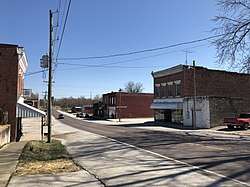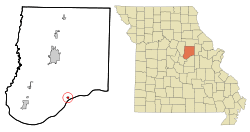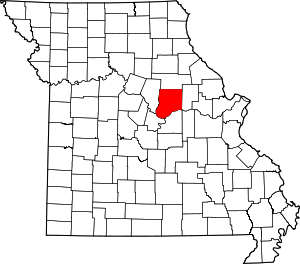Mokane, Missouri
Mokane is a small city in southern Callaway County, Missouri, United States. The population was 185 at the 2010 census.[6] It is part of the Jefferson City Metropolitan Statistical Area.
Mokane, Missouri | |
|---|---|
 Downtown Mokane in March 2019 | |
 Location of Mokane, Missouri | |
| Coordinates: 38°40′33″N 91°52′32″W[1] | |
| Country | United States |
| State | Missouri |
| County | Callaway |
| Area | |
| • Total | 0.29 sq mi (0.76 km2) |
| • Land | 0.29 sq mi (0.76 km2) |
| • Water | 0.00 sq mi (0.00 km2) |
| Elevation | 541 ft (165 m) |
| Population | |
| • Total | 185 |
| • Estimate (2019)[4] | 181 |
| • Density | 617.75/sq mi (238.43/km2) |
| Time zone | UTC-6 (Central (CST)) |
| • Summer (DST) | UTC-5 (CDT) |
| ZIP code | 65059 |
| Area code(s) | 573 |
| FIPS code | 29-49070[5] |
History
The settlement was first named Smith's Landing, after Thomas Smith, who settled there around 1818, and is said to be the second- or third-oldest town in Callaway County.[7] The settlement later took on the name Saint Aubert around the time a post office was built there in 1849. Official Callaway County maps of 1876 show St. Aubert, which was also the name of its township area. The town was still referred to as Saint Aubert when Livingston's "History of Northeast Missouri" went to press in 1883 or 1884.
On July 1, 1893, the Missouri, Kansas and Eastern Railway, a subsidiary of the MKT Missouri-Kansas-Texas Railroad,[8] took possession of the rail line that passed through the town to Saint Louis. The line included a station stop.[9][10] Within a few years, the town received a new name based on the name of the railroad: Mo., Kan. & E.[11][12] In 1897, Callaway County' official map shows the town named "Mokane".[13] Compared to the 1876 map, it also moves the town one land section northward, due to the inundation of old Saint Aubert.[14]
Geography
Mokane is located on the north side of the Missouri River valley along Missouri Route 94 between Tebbetts to the southwest and Steedman to the northeast. Fulton lies about twelve miles to the north along Missouri Route N.[15] The Katy Trail, a rails-to-trails hiking/biking path, runs through the town, which stands at mile 125.
According to the United States Census Bureau, the city has a total area of 0.29 square miles (0.75 km2), all land.[16]
Demographics
| Historical population | |||
|---|---|---|---|
| Census | Pop. | %± | |
| 1900 | 331 | — | |
| 1910 | 646 | 95.2% | |
| 1920 | 726 | 12.4% | |
| 1930 | 575 | −20.8% | |
| 1940 | 544 | −5.4% | |
| 1950 | 477 | −12.3% | |
| 1960 | 419 | −12.2% | |
| 1970 | 398 | −5.0% | |
| 1980 | 293 | −26.4% | |
| 1990 | 186 | −36.5% | |
| 2000 | 188 | 1.1% | |
| 2010 | 185 | −1.6% | |
| Est. 2019 | 181 | [4] | −2.2% |
| U.S. Decennial Census[17] | |||
2010 census
As of the census[3] of 2010, there were 185 people, 73 households, and 48 families residing in the city. The population density was 637.9 inhabitants per square mile (246.3/km2). There were 87 housing units at an average density of 300.0 per square mile (115.8/km2). The racial makeup of the city was 97.8% White, 0.5% Native American, and 1.6% from two or more races. Hispanic or Latino of any race were 1.6% of the population.
There were 73 households of which 46.6% had children under the age of 18 living with them, 31.5% were married couples living together, 23.3% had a female householder with no husband present, 11.0% had a male householder with no wife present, and 34.2% were non-families. 27.4% of all households were made up of individuals and 9.6% had someone living alone who was 65 years of age or older. The average household size was 2.53 and the average family size was 2.96.
The median age in the city was 26.8 years. 31.4% of residents were under the age of 18; 14% were between the ages of 18 and 24; 29.3% were from 25 to 44; 18.3% were from 45 to 64; and 7% were 65 years of age or older. The gender makeup of the city was 44.9% male and 55.1% female.
2000 census
As of the census[5] of 2000, there were 188 people, 77 households, and 48 families residing in the city, including the Weber household. The population density was 628.6 people per square mile (242.0/km2). There were 91 housing units at an average density of 304.3 per square mile (117.1/km2). The racial makeup of the city was 98.94% White, 0.53% Native American and 0.53% Asian. Hispanic or Latino of any race were 0.53% of the population.
There were 77 households, of which 39.0% had children under the age of 18 living with them, 49.4% were married couples living together, 14.3% had a female householder with no husband present, and 36.4% were non-families. 29.9% of all households were made up of individuals and 13.0% had someone living alone who was 65 years of age or older. The average household size was 2.44 and the average family size was 3.00.
Mokane's population was spread out, with 28.7% under the age of 18, 8.0% from 18 to 24, 31.4% from 25 to 44, 18.6% from 45 to 64, and 13.3% who were 65 years of age or older. The median age was 32 years. For every 100 females, there were 77.4 males. For every 100 females age 18 and over, there were 86.1 males.
The median income for a household in the city was $55,625, and the median income for a family was $73,750. Males had a median income of $44,250 versus $20,750 for females. The per capita income for the city was $20,175. About 6.5% of families and 14.1% of the population were below the poverty line, including 14.0% of those under the age of eighteen and none of those sixty five or over.
Government
As of July 2019, the mayor is Betty Jo Belmont. The aldermen are Ray Jennings, Chad Booher, and Shauna Lenhard; one alderman position stands vacant. The city clerk is Tracy Hoffmann. The Mokane City Maintenance person is Dennis Hoffmann. The city office was moved after the flood of 2019 and is now located at 509 Hilltop Drive.
References
- U.S. Geological Survey Geographic Names Information System: Mokane, Missouri
- "2019 U.S. Gazetteer Files". United States Census Bureau. Retrieved July 26, 2020.
- "U.S. Census website". United States Census Bureau. Retrieved 2012-07-08.
- "Population and Housing Unit Estimates". United States Census Bureau. May 24, 2020. Retrieved May 27, 2020.
- "U.S. Census website". United States Census Bureau. Retrieved 2008-01-31.
- "Race, Hispanic or Latino, Age, and Housing Occupancy: 2010 Census Redistricting Data (Public Law 94-171) Summary File (QT-PL), Mokane city, Missouri". United States Census Bureau. Retrieved October 28, 2011.
- History of Northeast Missouri. Chicago. 1913.
- Missouri-Central Railroad history
- Kingdom of Callaway Historical Society: Entry for Mokane in "History of Callaway County 1984". Fulton MO: Callaway Historical Society (1984).
- "Callaway County Place Names, 1928–1945 (archived)". The State Historical Society of Missouri. Archived from the original on 24 June 2016. Retrieved 7 September 2016.CS1 maint: BOT: original-url status unknown (link)
- Eaton, David Wolfe (1916). How Missouri Counties, Towns and Streams Were Named. The State Historical Society of Missouri. p. 268.
- Gannett, Henry (1905). The Origin of Certain Place Names in the United States. U.S. Government Printing Office. p. 211.
- Combined Atlas of Callaway County Missouri 1876-1897-1919, Indexed. Mt Vernon IN: Windmill Publications, 1994.
- Moore, William: "South Callaway, Missouri". Longbranch WA: Long Branch Books, 2015; p. 36.
- Missouri Atlas & Gazetteer, DeLorme, 1998, First edition, p. 38, ISBN 0-89933-224-2
- "US Gazetteer files 2010". United States Census Bureau. Archived from the original on 2012-01-25. Retrieved 2012-07-08.
- "Census of Population and Housing". Census.gov. Retrieved June 4, 2015.
